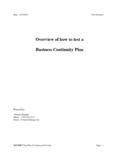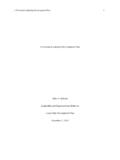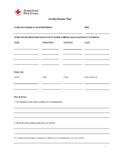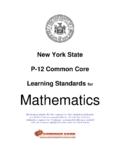Transcription of Sample Operations & Maintenance Plan for Mold …
1 Sample Operations &. Maintenance plan for mold &. Moisture Control in Public Housing Agencies This plan is provided for informational purposes and is a suggested policy only, It should be reviewed and modified to meet the PHA's needs and address local and state regulations. Adherence to this suggested plan does not constitute compliance with any applicable laws or regulations or duty to provide care. You are urged research and monitor any applicable federal, state and local regulations regarding the subject of mold . Bernard J. Morosco is not responsible for errors and omissions regarding this plan and it is highly recommended that the advice of counsel and appropriate government agencies be sought prior to adopting this as an O & M plan . 2003 BERNARD J. MOROSCO 1. GENERAL INFORMATION. Concern about Indoor Air Quality and specifically mold growth in public housing residences and common areas is increasing. As an industry there are many unanswered questions about potential health effects of mold , and it is considered to be proper and prudent for Public Housing Authority Staff 1.
2 Repair any known conditions involving excessive moisture that could, under the right conditions, lead to mold growth and, 2. Clean and remove any mold growth when it occurs. In order to accomplish this, it is important to establish a cooperative partnership between the housing management staff and residents so that conditions that require attention are identified and dealt with promptly. TRAINING. Currently there are no specific training requirements currently mandated by state and federal law for workers who may remediate mold as part of their responsibilities. This does not negate the importance of proper and qualified remediation and prevention training. On-site staff should receive training necessary to carry out their responsibilities with respect to communicating with residents; cleaning, removing, and restoring damaged surfaces, and documenting all remediation efforts. Although there are no currently established Permissible Exposure Levels (PELs) or Threshold Limit Values (TLVs) for mold , as part of the required training under OSHA's Hazard Communication Standard (29 CFR ), workers must be informed about safe work practices for using various chemicals, including disinfectants, and personal protective equipment, which may be a part of a mold response.
3 Workers who may be involved in cleanup of extensive mold should be supplied with appropriate respirators, which may involve compliance with OSHA's Respiratory Protection Standard (29 CFR. ). Additional information on these regulations is available at and respectively. On-site staff should be familiar with procedures to deal with water intrusion/excessive moisture and appropriate remediation techniques for water damaged surfaces. Workers should also review any company-specific policies and procedures and be familiar with the appropriate corporate/management contact person, should decisions need to be made concerning testing or activities beyond their scope of training or responsibility. ROUTINE Maintenance . Routine Maintenance and turnover activities provide on-site staff with the opportunity to monitor and correct any conditions involving moisture that could lead to the growth of mold . Treatment of mold should be incorporated into general project Maintenance activities.
4 Staff should perform an inspection for mold as part of any type of unit inspection. Any visual mold growth should be immediately and properly remediated as part of the requirements of the Maintenance process. Follow the Sample monitoring checklist. Staff should also be encouraged to monitor the property for signs of moisture, water damage or situations that may lead to conditions favorable for 2003 BERNARD J. MOROSCO 2. mold growth ( , leaking faucets, broken sprinkler heads) when conducting other Maintenance activities. Also be aware of situations such as carpet cleaning techniques, which may leave carpets too damp and run the risk of creating conditions favorable for mold growth. INSPECTION. A visual inspection is the primary step in identifying the extent of moisture damage, which may create conditions favorable for mold growth. To the maximum extent possible ceiling tiles, gypsum wallboard, cardboard, duct liner, wood, carpet, paper, and other cellulose surfaces should be given careful attention during a visual inspection.
5 Kitchens, bathrooms, windows, and HVAC systems should also be scrutinized. An earthy or musty odor, may also indicate that mold is present. The use of a moisture meter, to measure the saturation in building materials, is useful in evaluating the extent of water damage and determining when the appropriate moisture level has been restored. Under further investigation, it may be necessary to look inside of wall cavities or filter areas to determine the extent of any water damage or mold growth. Once mold growth is observed, the extent of any damaged area should be evaluated in order to determine appropriate remedial strategies based on EPA guidance. Consult list of materials and equipment that are needed to deal with water intrusion/ mold remediation. EPA's TIPS FOR Maintenance PERSONNEL. o Fix leaky plumbing and leaks in the building envelope as soon as possible. o Watch for condensation and wet spots. Fix source(s) of moisture intrusion as soon as possible.
6 O Prevent moisture due to condensation by increasing surface temperature or reducing the moisture level in air (humidity). To increase surface temperature, insulate or increase air circulation. To reduce the moisture level in air, repair leaks, increase ventilation (if outside air is cold and dry), or dehumidify (if outdoor air is warm and humid). o Keep heating, ventilation, and air conditioning (HVAC) drip pans clean,flowing properly, and unobstructed. o Vent moisture-generating appliances, such as dryers, to the outside where possible. o Maintain low indoor humidity, below 60% relative humidity (RH), ideally 30-50%, if possible. o Perform regular building/HVAC inspections and Maintenance as scheduled. o Clean and dry wet or damp spots within 48 hours. o Don't let foundations stay wet. Provide drainage and slope the ground away from the foundation. PROPER HVAC Maintenance . Improperly cycling HVAC systems, or improper use by the residents, can result in conditions of excessive humidity, which could lead to mold growth.
7 Develop Maintenance guidelines based on manufacturer's specifications for HVAC ventilation equipment (including appropriate settings, filter changes, and cleaning). 2003 BERNARD J. MOROSCO 3. Sample GUIDELINES FOR PROCESSING A Maintenance WORK ORDER. Maintenance Work Order Office 1. Fill out a work order and in doing so, record the observations of the resident/ Maintenance personnel regarding the presence of conditions that may be favorable to mold growth, or whether they believes mold growth is present. If a health concern is expressed or property damage is reported, immediately contact [NAME OF CONTACT] and submit an damage report. 2. Treat the work order as a priority. 3. Complete the Work Order Tracking Log. Maintain the Log in the Maintenance office. At the Work Order Location 1. Determine the nature and extent of conditions favorable for mold growth, or mold , if any. Determine the source of any water infiltration or excessive moisture interior and exterior.
8 2. If a source of water or excessive moisture is found: Stop the leak or cause of excessive moisture and dry all affected areas completely immediately, or within 24 hours of notification. 3. If no mold is found: Send Resident Follow-up Letter indicating results of investigation. 4. If mold is found: Clean up the mold following the procedures outlined 5. Use the work order (or Resident Follow-up Letter) to inform the resident of the corrective action completed and additional steps to be taken, if any. Back at the Maintenance Work Order Office 1. Before determining that the remediation will require the use of outside professionals or that a unit be vacated, consult [NAME OF CONTACT] for guidance. 2. Complete the Work Order Tracking Log to reflect what action was taken. Within 7 10 Days 3. Send a Resident Follow-up Letter. 4. Log the follow-up action on the Work Order Tracking Log. 2003 BERNARD J. MOROSCO 4. Sample INSPECTION FORM. Project/Development:_____Unit Number:_____.
9 Date of Inspection:_____. Check boxes for Clean (areas are clean, equipment is properly functioning, no work required) or Corrected (deficiences repaired). File completed checklist in unit Maintenance file. Unit exterior (signs of holding water or missing Kitchen (note any signs of current or past Bedroom(s) Indicate Locations building components) clean/corrected signs of moisture) clean/corrected clean/corrected Check Roof Check Inside all Cabinets Check Windows Check Gutters/Downspouts Check Sink Check Sliding Doors Check Stairs Check Faucets Check Walls and Ceilings Check Landscape Check Flooring Check Carpet Check Exterior Utility Closet Check Walls and Ceilings Check Carpet Tack Strip in Corners Check Irrigation System Check Doors Check Closet(s). Interior Entry (note any signs of current or past Check Windows signs of moisture) clean/corrected Check Door sufaces Check Refrigerator Closets (note any signs of current or past signs of moisture) clean/corrected Check Inside of Closet Check Icemaker (connections) Check Shelving Check Windows Check Dishwasher (underneath) Check Walls and Ceilings Check all Baseboards Check Waste disposal Check Walls and Ceilings Check Washing Machine HVAC.
10 Clean/corrected Check Flooring Check Hoses Check Operation Check Carpet Check Dryer Check Air Circulation Check Carpet Tack Strip in Corners Check Dryer Vent Check Thermostat Check Evaporator Coil Living Room Bathroom(s) Indicate Location Check Condensate Pan clean/corrected clean/corrected Check Inside of Closet Check Lavatory Sinks Check Condenser Coil Check Doors Check Bathtubs/Showers Check Condenser Fan Motor Check Windows Check Toilets Check Furnace Check all Baseboards Check Inside all Cabinets Check Baseboard Heaters Check Walls and Ceilings Check Shelving Check all Vents Check Flooring Check Flooring Change Filters Check Carpet Check Walls and Ceilings Check Carpet Tack Strip in Corners Check Interior Doors Check Fireplace Check Windows Check Bathroom Exhaust Fans Patio/Balcony (note any signs of current or past signs of moisture) clean/corrected Check Roof Hallways (note any signs of current or past signs of moisture) clean/corrected Check Exterior Doors Check Walls and Ceilings Check Deck Surface Check Interior Doors Check Water Heater (all fittings) Check Windows Check Storage Closet Check Carpet Check Exterior Paint Check Carpet Tack Strip in Corners Inspector:_____.






